By Caroline Cohn, Margaret Love, et al. - National Consumer Law Center, Inc. and Collateral Consequences Resource Center
For the nearly one-third of adults in the U.S. with a record of arrest or conviction, their record is not simply part of their past but a continuing condition that impacts nearly every aspect of their life. Their record makes it hard to get a job and support a family, secure a place to live, contribute to the community, and participate fully in civic affairs.
In recent years, most states have passed laws aimed at restoring economic opportunity, personal freedoms, and human dignity to millions of these individuals by providing a path to clear their record. But for too many, this relief remains out of reach because of monetary barriers, including not only the cost of applying for record clearing but also the requirement in many jurisdictions that applicants satisfy debt incurred as part of the underlying criminal case before they can have their record cleared. This can be a high bar: the total amount of fines and fees can run to thousands of dollars for even minor infractions and can be considerably higher for felonies.
People prevented from clearing their record because they cannot afford to pay are usually those most in need of relief. And, perversely, because a record significantly impairs economic opportunity, having an open record makes it harder to pay off fines and fees and therefore harder to qualify for record clearing. This burden falls especially heavily on Black and Brown communities, which are more likely to have high concentrations of both criminal records and poverty because of structural racism in criminal law enforcement and in the economy. Ability-to pay tests and similar waiver approaches to reduce or eliminate monetary barriers to record clearing have been shown to be poor safeguards in many contexts.
FINDINGS: NATIONWIDE SURVEY OF COURT DEBT AS A BARRIER TO CLEARING A CONVICTION RECORD
This report explores the extent to which restricting access to record clearing based on outstanding criminal fines, fees, costs, and restitution—collectively known as “court debt”—may prevent poor and low-income people from getting a second chance. After surveying research on the importance of record clearing and the mushrooming financial burdens imposed on criminal defendants, it analyzes the extent to which outstanding court debt is a barrier to record clearing under the laws of each of the 50 states, the District of Columbia, and the federal system. Our study focuses in particular on generally applicable statutory authorities for clearing adult criminal convictions; it excludes record-clearing authorities available for other categories of records (e.g., non-conviction records) or for specific categories of individuals (e.g., victims of human trafficking).
We found considerable variation and complexity in how jurisdictions treat outstanding court debt in the context of conviction record clearing. We identified six general categories into which jurisdictions fall, and we analyzed the specific details of each jurisdiction’s law.* The map below shows how we categorized each state, with a legend describing in general terms the criteria for inclusion in each category.
Our research revealed the following:
In almost every jurisdiction, outstanding court debt is a barrier to record clearing in at least some cases, either rendering a person entirely ineligible for record relief or making it difficult for them to qualify for this relief.
At the same time, however, only 6 of the 50 states require payment of all court debt in order to qualify for record clearing—evidence that most state policymakers do not think that all court debt should have to be paid off for an individual to benefit from record clearing.
While some of the states that have enacted automatic record-clearing laws do not restrict eligibility based on outstanding court debt, others do, such that making record-clearing automatic does not necessarily obviate this monetary barrier.
In many states it is difficult to determine the relevance of outstanding court debt in the record-clearing context, and even more difficult to predict whether a person with outstanding court debt will be successful in obtaining relief. This uncertainty makes it difficult both to understand eligibility for record clearing and to successfully navigate the application process, and it creates the potential for inconsistencies in how the law is applied and who obtains relief.
Although this report focuses on how court debt operates as a barrier to record clearing for those without the means to pay, it also describes the variety of filing and administrative fees that often must be paid to apply for record clearing. The high cost of application also creates a barrier to a fresh start
RECOMMENDATIONS
Based on our research, we offer the following recommendations:
Court debt should never be a barrier to record clearing: Qualification for record clearance should not be conditioned on payment of court debt, and outstanding court debt should not be a basis for denying relief, regardless of whether record clearing is petition-based or automatic.
Application-related costs, including filing fees, should never be a barrier to record clearing: States should adopt automatic record-clearing processes that do not require individuals to incur costs to have their records cleared. States with petition-based record clearing should not require people seeking relief to pay any filing fees or other costs to submit a petition or to obtain or effectuate relief.
Jurisdictions should collect and report data on monetary barriers to record clearing: Jurisdictions where record clearing may be denied on the basis of outstanding court debt should collect and report data reflecting the impact of these barriers on record clearing. Jurisdictions should also collect data reflecting the impact of filing fees and other application-related costs on obtaining relief
National Consumer Law Center, Inc. and Collateral Consequences Resource Center 2022. 62p.














